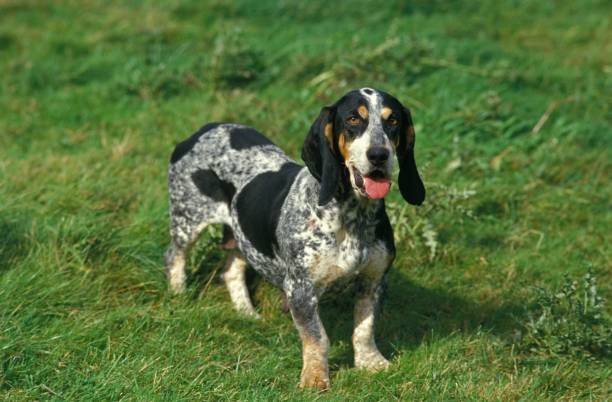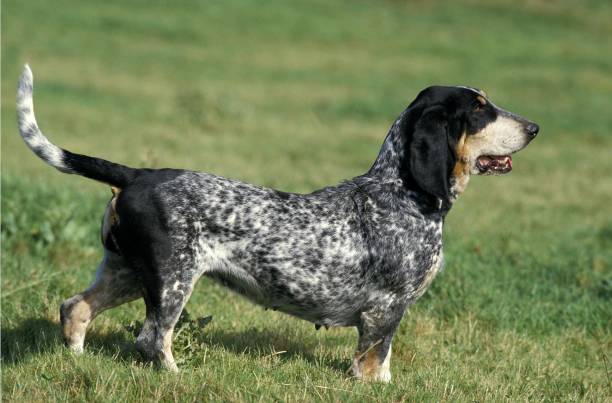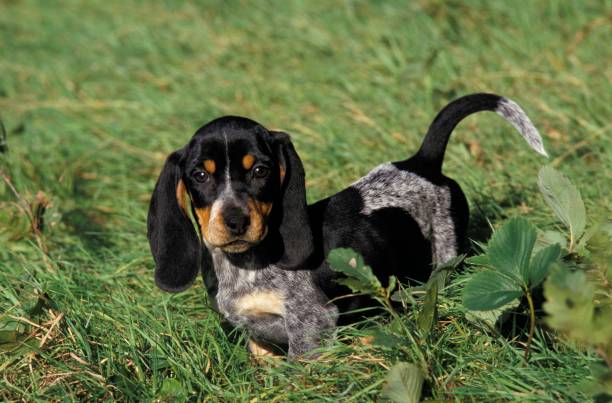Basset Bleu de Gascogne

Breed History:
The Basset Bleu de Gascogne (Blue Gascony Basset) is a French scent hound with roots tracing back to the 14th century in the region of Gascony, France. It descends from the Grand Bleu de Gascogne, a taller and older hound, and the Basset Hound. It was developed to be a shorter, more agile hunter for small game like rabbits and hares.
Originally bred for tracking and hunting on foot through rough terrain, the breed declined in the 19th century but was revived by dedicated breeders in the early 20th century. Though still rare outside France, it’s appreciated for its unique appearance, voice, and determined scenting ability.
Height: 34-38 cm
Weight: 16-18 kg
Size: Medium
Life Expectancy: 10–14 years

Breed Appearance:
The Basset Bleu de Gascogne is a long-bodied, low-set hound with a distinctive mottled or "blue" coat, created by black and white hairs intermingling. It has a noble head, long ears that curl inwards, and dark, expressive eyes.
The coat is short, dense, and coarse, with typical markings including black patches and tan points on the face, eyebrows, and legs. The dog’s overall expression is gentle and alert.
Breed Type – Scent Hound:
As a scent hound, the Basset Bleu is prized for its keen nose, endurance, and distinctive baying voice. It was bred to trail game independently and thrives when given a job.
Friendly, social, and adaptable, this breed makes a good companion dog but retains strong hunting instincts. It works well in packs and bonds strongly with its family.

Training:
Training should be consistent, patient, and reward-based. While intelligent, the breed can be stubborn and easily distracted by scents.
-
Use positive reinforcement techniques
-
Start early socialisation and basic obedience
-
Recall may be difficult due to their tracking drive
-
Not suitable for off-leash freedom in open areas
Mental stimulation through scent work or puzzle toys is very beneficial.
Health & Care:
Generally, a healthy breed, but possible issues include:
-
Ear infections due to long, droopy ears
-
Obesity if under-exercised
-
Intervertebral disc disease (IVDD) due to a long back
-
Hip dysplasia (less common than in larger breeds)
Routine vet care, weight management, and ear cleaning are important. Exercise helps prevent back and weight-related issues.

Living Conditions:
Adaptable to urban or rural environments, the Basset Bleu does well in homes with secure outdoor space. They are not overly energetic indoors but should not be left alone for long periods.
-
Suited for families or individuals who enjoy daily walks
-
Needs a secure yard due to its scent-driven wandering tendency
-
Does best with companionship—can become vocal if lonely
Exercise:
Moderate exercise needs:
-
Daily walks (30–60 minutes)
-
Leashed exploration is ideal to satisfy their nose
-
Scent games, tracking exercises, or calm play in a yard
Avoid excessive jumping or stair climbing to protect the back.
Grooming:
Low grooming needs:
-
Weekly brushing to control shedding
-
Regular ear cleaning to prevent infections
-
Baths occasionally, or when dirty
-
Routine nail trimming and dental care
Despite their rugged appearance, they’re relatively clean and easy to maintain.

Advantages:
-
Gentle, affectionate, and friendly
-
Great scent-tracking ability and strong work ethic
-
Generally quiet indoors
-
Unique blue-speckled coat and noble appearance
-
Loyal and enjoys family companionship
-
Gets along well with other dogs
Disadvantages:
-
Can be stubborn and hard to train off-leash
-
Strong scent drive—may wander or ignore commands
-
Prone to ear and back issues if not cared for properly
-
Needs regular exercise to avoid weight gain
-
Not ideal for homes without a fenced yard
-
Loud baying when excited or left alone too long

